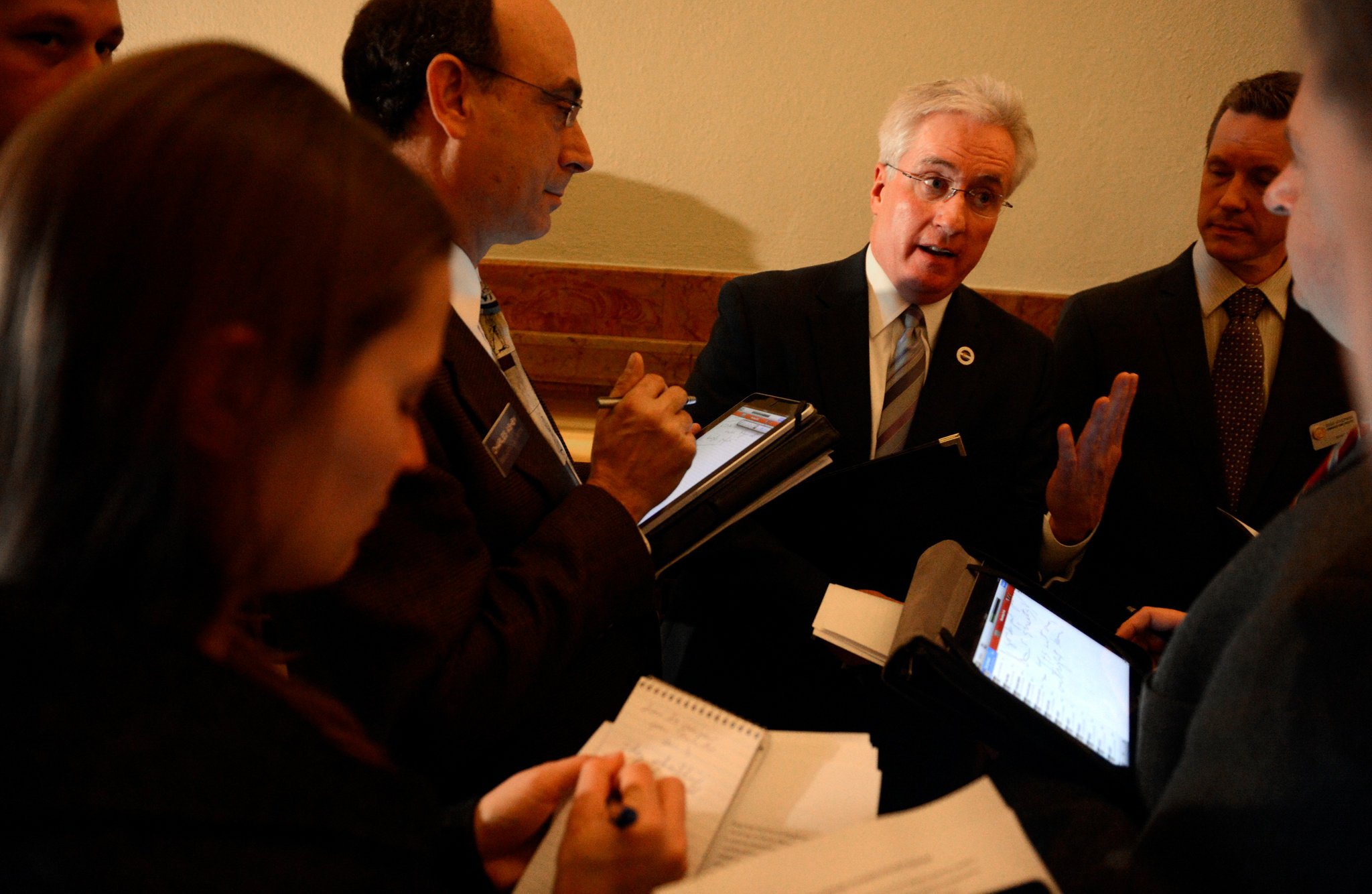
The N.R.A.’s impact comes, in large part, from the simplicity of the incentives it presents to political candidates: letter grades, based on their record on the Second Amendment, that guide the N.R.A.’s involvement in elections. Lawmakers who earn an “A” rating can count on the group not to oppose them when they run for re-election or higher office.
For candidates who earn lower grades, the group deploys a range of blunt-force methods against them. The N.R.A. mails the voter guides to its five million members, displaying images of favored candidates on the front, and some state chapters bombard supporters with emails about coming elections.
The organization’s calculation is that its money is better spent on maintaining a motivated base of gun rights supporters than on bankrolling candidates directly.
“Everyone wants a simplistic answer, which is they buy votes,” said Harry L. Wilson, a political scientist at Roanoke College and the author of “Guns, Gun Control, and Elections.” “But it is largely incorrect. The N.R.A.’s power is more complex than people think.”
Compared with the towering sums of money donated to House and Senate candidates in the last cycle — $1.7 billion — the N.R.A.’s direct contributions were almost a rounding error.
The N.R.A. directly donated a total of just $1.1 million to candidates for federal office in 2016, with 99 percent of that money going to Republicans, while giving a total of only $309,000 in direct contributions to state legislative candidates in 2016 and 2017, according to tallies by the Center for Responsive Politics, which tracks federal donations, and the National Institute on Money in State Politics, which tracks state-level donations.

Credit
RJ Sangosti/The Denver Post, via Getty Images
Those amounts are dwarfed by the largess of other major contributors. Comcast, through its political action committee and its employees, directly donated $12.7 million in the 2016 campaign cycle to federal candidates or political parties, and the committee for Pfizer, the pharmaceutical giant, and its employees directly donated nearly $3 million, according to the Center for Responsive Politics tallies.
Those numbers are tied to campaign finance reports filed by individual lawmakers. The N.R.A.’s spending on messages like its voter guides does not need to be disclosed, because it falls into the category of a membership-based group communicating with its members.
When candidates waver in their support for sweeping gun rights, the group does not hesitate to turn on them. After Ted Strickland, a Democrat who earned the N.R.A.’s endorsement as a candidate for governor of Ohio, backed a ban on assault weapons, the organization spent more than $1.5 million in so-called independent expenditures, like TV ads, to defeat him in a 2016 bid for the Senate.
Ms. Mitchell, a Republican election lawyer who sat on the group’s board for nearly a decade, said its record of loyalty to those who stand by it was a cornerstone of its influence. “They know that it’s not easy, sometimes, to stick with the N.R.A.,” she said of the group’s leadership. “At times like this, it’s very easy to get stampeded by the media and the left.”
While the N.R.A. cuts relatively few checks to individual lawmakers — a fact that has been noted by The Tampa Bay Times, among others — it does devote tens of millions of dollars to ads backing its preferred candidates or criticizing its opponents, often with vividly alarmist messages about crime and self-defense.
The N.R.A., through its various legal entities, raises money for its political and lobbying efforts and other activities from two primary sources: member dues and contributions from outside supporters, including gun makers like Smith & Wesson and political groups like Freedom Partners, the Koch family-backed organization.
The group has fought to keep the identity of many of its biggest contributors secret, although an audit document filed with the State of North Carolina showed that its total budget was about $420 million in 2016.
The N.R.A. spent $20 million in that year’s election cycle on ads and other campaign tactics intended to persuade voters to reject Hillary Clinton and an additional $11 million to support Donald J. Trump — money that is not marked down as a direct contribution to Mr. Trump, because the N.R.A. spent the cash on its own.
At the state level, the N.R.A. also spends much more on these independent expenditures than on direct contributions to candidates.
Expenditures like these are the area of real growth for the N.R.A.: At the federal and state levels, overall independent spending by the group jumped from $9.3 million in the 2009 election cycle to at least $55 million in 2016, according to an analysis by the National Institute on Money in State Politics that was published on Friday.
“Its most precious resource is perhaps the passion and political engagement of its members and its fans,” said Sheila Krumholz, executive director of the Center for Responsive Politics.
This type of spending also comes with risks, particularly when the group ventures into so-called purpler parts of the country, where the two parties have similar levels of support. The N.R.A.’s presence can draw in an increasingly well-funded collection of groups that support gun control, and can sometimes unnerve moderate voters.

Credit
Jay LaPrete/Associated Press
Last fall in Virginia, where the N.R.A. is headquartered and once held commanding clout over the state government, Democrats swept all of the state’s major offices after campaigning loudly against the organization. The state’s attorney general, Mark Herring, a Democrat whom the N.R.A. had targeted for defeat, said the group had insisted on defending a platform that was “becoming more and more untenable” with voters in the political middle.
“There were parts of the state where they wouldn’t run their ads because they knew it would drive voters to supporting me,” Mr. Herring said, adding of the N.R.A.’s campaign spending: “It did elevate the conversation, the issue, but it was also one that I wanted to talk about.”
Still, in more rural areas where voters fiercely support gun rights, Democrats have routinely paid a price in recent years for crossing the N.R.A.
In Colorado, where a Democratic-held state government passed new gun regulations after the 2012 massacre at a movie theater in Aurora, the N.R.A. helped bankroll successful recall campaigns against two Democratic lawmakers, including the powerful president of the State Senate.
The former Senate leader, John P. Morse, who lost his seat in 2013 by a margin of 319 votes, said the N.R.A. had played a decisive role in motivating Second Amendment voters in a low-turnout race. After that, Mr. Morse said, Democrats have “run like scalded rats from the issue.”
“They turn out people that already agree with them,” Mr. Morse said of the N.R.A. “The reason why gun policy is where it is in this country, at this point, is that the rest of us are too lackadaisical.”
The organization has focused heavily in recent years on high-profile Senate elections in conservative-leaning states that are key to the balance of power in Congress, amassing an imposing record of victories, including that of Senators Thom Tillis of North Carolina and Tom Cotton of Arkansas.
But it has had major losses, too, including in the Senate special election in Alabama late last year, in which it spent money to try to defeat Doug Jones, a Democrat who challenged Roy S. Moore.
Over all, the success rate of the N.R.A. ebbs and flows with political trends. With Mr. Trump on the ballot, candidates it supported directly at the federal level in 2016 won 73 percent of the time, while its preferred candidates won only 44 percent of the time in 2008, when Barack Obama was first elected president.
In almost all forms of spending — direct campaign contributions, independent expenditures and lobbying — gun rights groups have far outspent gun control groups in recent decades, according to data from the Center for Responsive Politics. However, spending that advocates gun control has picked up in recent years, fueled by groups backed by former Representative Gabrielle Giffords, an Arizona Democrat who was wounded in a 2011 shooting, and by Michael R. Bloomberg, the billionaire former mayor of New York.
There have been hints in recent days, with the protests after the Parkland shooting and a string of businesses cutting ties with the N.R.A. — as well as a fiery and defensive speech delivered by its leader at a conservative conference — that the group is losing ground. Even some of its key political supporters, like Gov. Rick Scott of Florida, a Republican, and top lawmakers in the state, have proposed measures like raising the age limit for gun purchases to 21.
John Feinblatt, the president of Everytown for Gun Safety, a gun control group backed by Mr. Bloomberg, said he saw signs that the N.R.A.’s influence was in decline, despite a surge in 2017 in federal lobbying spending by the organization. He pointed to its inability last year to get legislation through the Republican Congress that would give legal gun owners the right to carry concealed weapons outside their home states.
“What we are seeing right now is a reversal of fortune,” Mr. Feinblatt said. “The truth is, they are making bad bets. And they are out of sync. Their power is diminishing by the day.”
Continue reading the main story
Powered by WPeMatico

